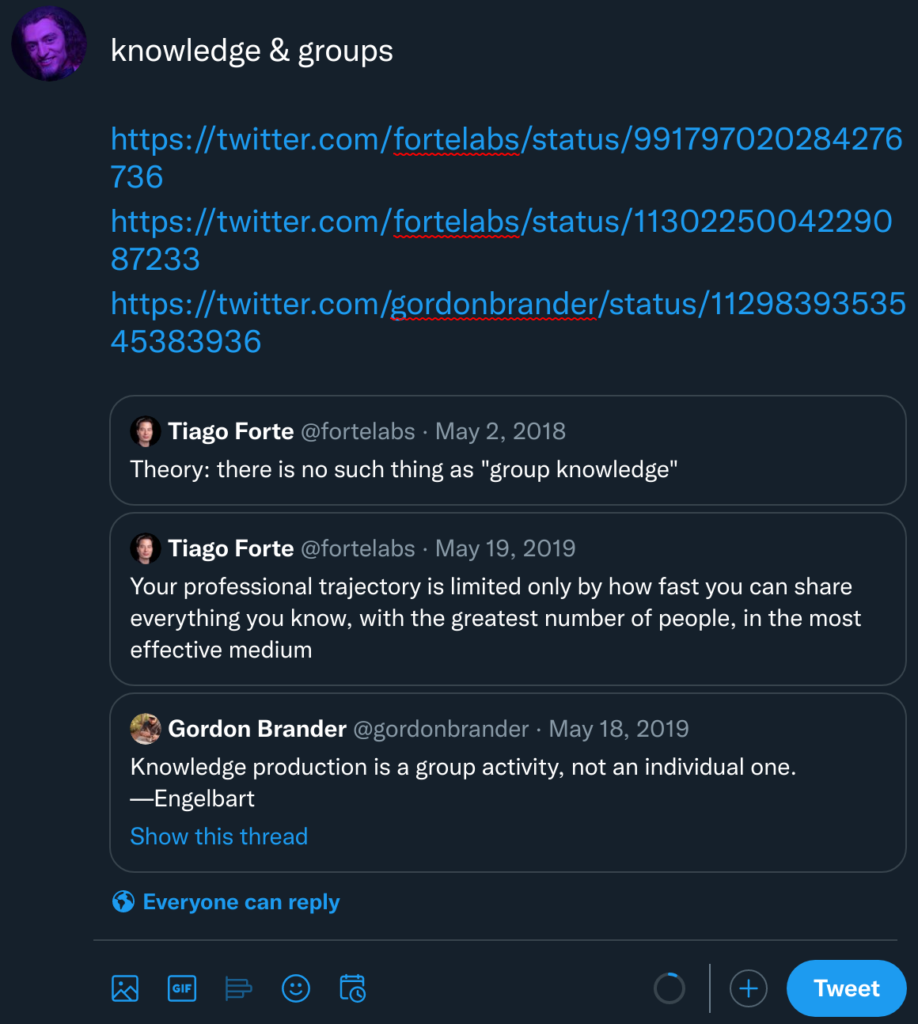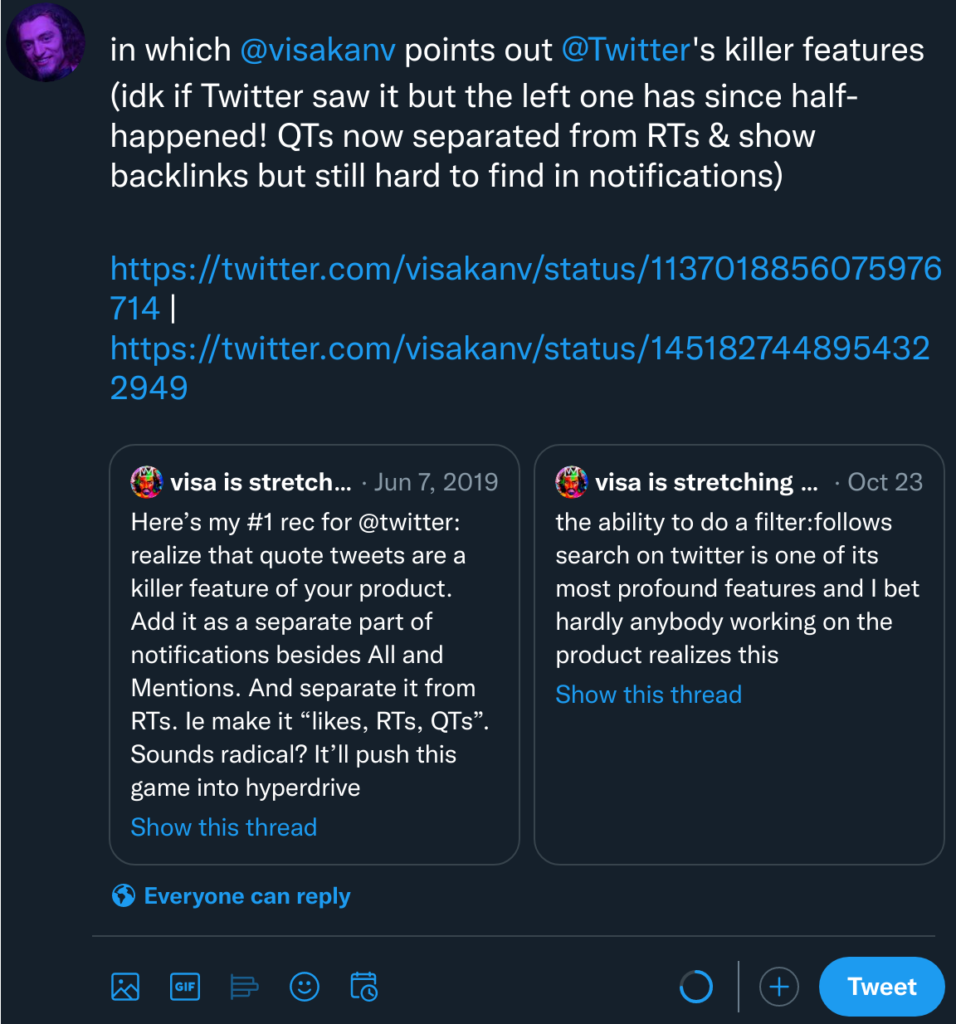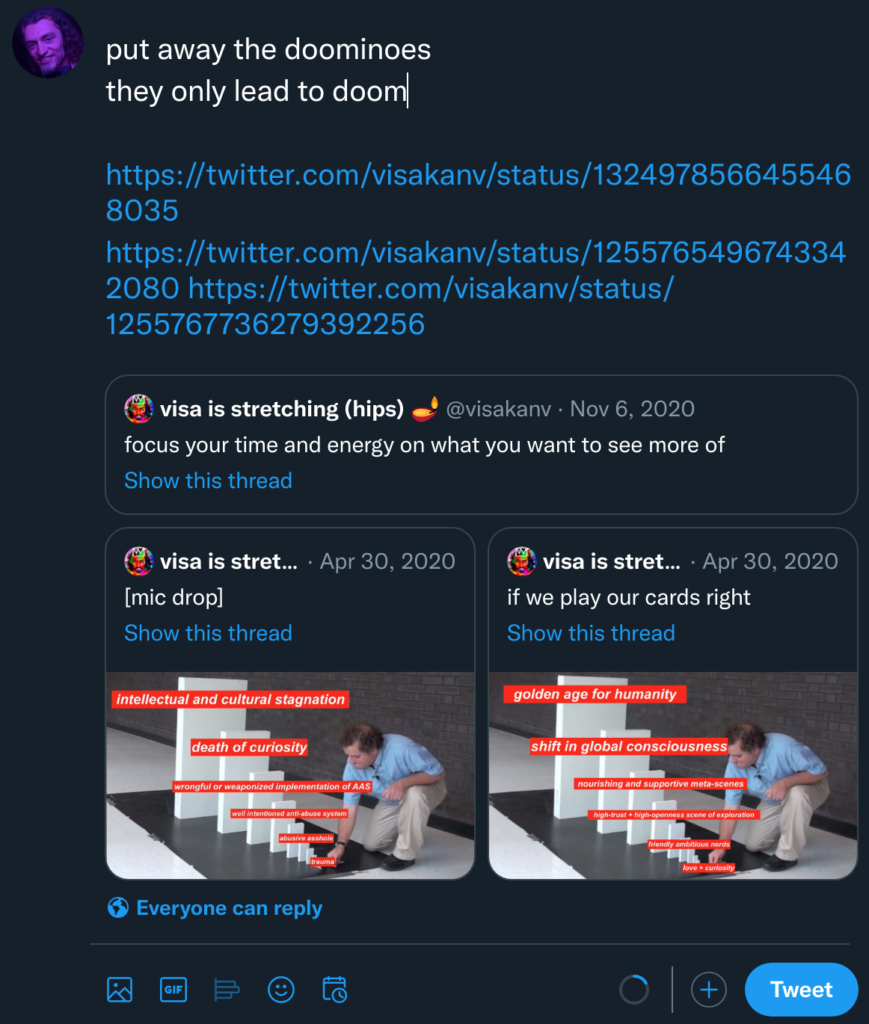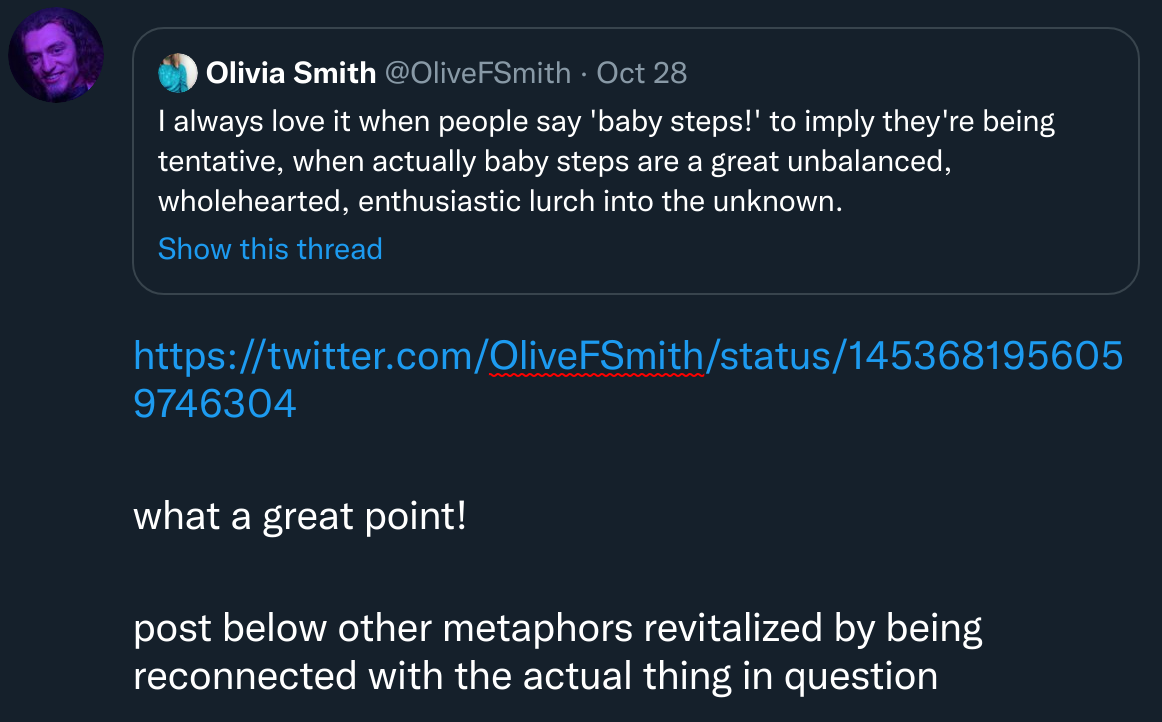As someone currently experiencing substantial amounts of collective intelligence on Twitter, here’s some of what I’m seeing as the emerging edge of new behaviors and culture, and one bottleneck on our capacity to think together and make sense of the world.
Some of us are pioneering a new experience of Twitter that’s amazing, and that wouldn’t be possible on any other platform that exists today.
Conversation is thinking together.
Collective intelligence is, at its core, good conversation.
Many people, on and off Twitter, think of it as a shouting fest, and parts of it are. And… at the same time, on the same app, with the same features but some different cultural assumptions, there are pockets where people are meeting the others, making scientific progress, falling in love, healing their trauma, starting businesses together, and sharing their learning processes with each other.
Those sorts of metrics—as hard to measure as they are—form a kind of north star for Twitter. This creature has the potential to be the best dating app (for some people) and a way better place for finding your dream job than LinkedIn (for many people). And so on.
Cities have increased creativity & innovation per capita per capita, ie when you add more people each person becomes more, because more people & ideas can bump into each other. The internet is a giant city, and this is far more true on Twitter than any other platform, particularly because of how tightly it allows the interlinking of ideas with Quote Tweets.
Twitter is very much about “what’s happening [now]” but, as the world has been collectively realizing over the past decade, simply knowing “what’s happening” in some isolated way is meaningless and disorienting. Meaning comes from filtering & distilling & contextualizing what’s happening, and this is part of what Twitter is already so brilliant for, because everyone can talk to everyone and the ultra-short-form non-editable medium encourages you to tweet today’s thoughts today rather than drafting them today, editing them tomorrow, then scheduling them for next week’s newsletter.
When someone makes a quote-tweet, they’re essentially saying “I have some thoughts I’d like to share, that relate to the tweet here”. This might be a critique of the quoted tweet/thread, or it might be using the quoted material as a sort of footnote of supportive evidence or further reading or ironic contrast. This meta-commentary is very powerful, whether it’s used by someone reflected “I think what I really meant to say here was” or someone framing a thread they just read as an answer to a particular question they and their followers might care about.
Currently, however, it’s impossible to QT two or more tweets at once. This means that in the natural ontology of Twitter, there is no way to properly compare or contrast or relate different thoughts.
This contributes, I think, to the fragmented & divergent quality of thinking on Twitter: the structure of the app makes it hard to express convergent thoughts. You can use screenshots… but then all context & interlinking & copy-pastability is destroyed. You can have a meta-thread that pulls a bunch of things together… but each tweet in that thread is still only referencing one other tweet, so there’s no single utterance that performs the act of relating other utterances.
The amount of utterances that need to connect two other pre-existing utterances is huge. Thoughts shaped like:
Similarly to how the #hashtag & @-mentions evolved from user behavior, and the Retweet functionality evolved out of people copying others tweets and tweeting them out with “RT @username: ” at the start, and Quote Tweeting evolved out of people pasting a link to another tweet within their tweet… MultiQT is a natural evolution of the “screenshot of multiple tweets” and “linking tweets together as a train of thought using multiple QTs in a thread” behaviors.
I didn’t even realize quite how much I’d want this until I started mocking up the screenshots below by messing with the html in the tweet composer and being so sad I couldn’t just hit “Send Tweet”. I can already tell that like @-mentions and RTs, once we’re used to this it’ll feel absurd to think we ever lived without it.
It’s not 100% clear to me what the ideal composer for this would look like, but we can get some inspiration from how pasting in images produces first one image, then two side-by side, then 1 & 2, then a 2×2 grid. MultiQT could work the same way, but it might be nice to have a bit more control over how they show up.
This might be tough, but I’ve got an interface design I think would be workable-enough, and it only took me an hour to think of it, so surely something good is possible here.
Here’s how it works:
So suppose you put 3 urls each on separate lines… you’d get this:

Or if you put 2 urls with no line breaks between them, they’d show up side-by-side in 2 columns. (I’m not totally satisfied with this… the urls are so long that they wrap around to the next line even if they’re technically only separated by a space. I’m not sure how to solve that but I’m sure there’s a way, or a similar syntax that would be about as good like putting a | or a + between tweets you want side-by-side… but also the preview would basically handle it)

It could get even more complex: if you put 1 url then on the next line 2 urls, you get something like this:

I think there’s a good case to be made for allowing quote tweets at the start of a tweet too. Sometimes your tweet is commentary on the other tweet but you want people to have a fresh experience of the other tweet before reading your commentary. And it’s slightly awkward to write “read this quoted tweet below. okay, now that you’ve read it… does it also seem to you to be ABC?”
This UI described above could be naturally extensible for that purpose: just put the tweet url at the top of the tweet, and voila!

(There would also need to be some sort of way to move it if you QT’d it directly using the Quote Tweet button that exists on each tweet.)
Twitter founder @jack describes extensively in his interview with Joe Rogan (spotify only) how almost all of the core features of Twitter evolved out of watching what powerusers were doing and were trying to do, and enabling that behavior by streamlining it in the app. The hashtag, the @-mention, the tweetstorm/thread, and more.
Making something possible instead of impossible changes the game. So does making something easy (or fast, or good) instead of merely possible.
Here’s a few examples of people wanting this feature to exist, including a couple of my friends very recently (without my having publicly talked about working on this blog post!)
The scene I hang out in on Twitter uses QTs extensively to interlink related ideas, eg answering someone’s question by linking an earlier tweet by ourselves or a friend. For some people, QTs are more associated with dunking or mobbing, but adding MultiQT shouldn’t exacerbate that problem and if anything points in the opposite direction because it’s hard to click through to both tweets so it encourages the use of QTs for purposes more like a citation or an immediate contrast.
There are many beautiful uses for Quote Tweets, and MultiQT deepens their power:
If you have other ideas for how MultiQT could be used (building on my list of X & Y relations above) or you also want this, comment below or hit me up on Twitter @Malcolm_Ocean.
Constantly consciously expanding the boundaries of thoughtspace and actionspace. Creator of Intend, a system for improvisationally & creatively staying in touch with what's most important to you, and taking action towards it.
Mars » 1 Dec 2021 »
Do you find twitter a good medium for distilling/filtering/contextualising? I always run into the problem that there’s not enough words to add appropriate nuance, and people seem to forget the context of a tweet even though you could just scroll up to see what it’s replying to. That, plus tweets being open to the entire public, seems to lead to a lot of strawmanning between different groups.
I do like that conversations are open to the entire public, but I find I need thick skin sometimes to ignore all the bad takes and willful misinterpretations. There’s zero culture of trying to interpret a tweet in charitable ways, and having a proper discussion is almost impossible unless you’re very deep in replies and basically only talking to one other person.
Have your say!